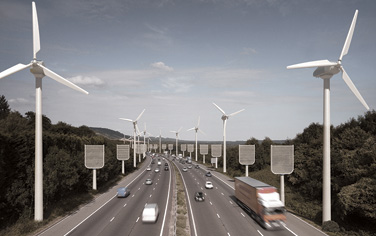The biology of Artificial Trees
Should the recent proposal to manufacture and install artificial trees be treated as a serious climate change mitigation strategy?
In the rush to develop climate change mitigation technologies, some truly bizarre ideas have been conceived of late.
One concept that has caught my eye recently is the “artificial tree” (otherwise known as a “synthetic tree“) that will use air-capture technology to remove CO2 from the atmosphere.
Unlike a real tree, the synthetic version has only one purpose; to ‘capture’ carbon. Yet it has been claimed in the media that these devices could entrap carbon 1000 times more efficiently than a real tree. Only time and independent research will allow us to determine the accuracy of such statements.

An artist’s impression of artificial trees. (Image source: IME)
As a plant scientist, I find the idea of artificial trees intriguing on so many levels.
Photosynthesis (the process that uses carbon from the air to convert light energy into chemical energy, and which results in the production of oxygen) is a truly amazing biological system that underpins all other life on earth.
From a carbon reduction perspective, the “problem” with plants is that being living organisms, they also respire, which means that a portion of the carbon that they ‘capture’ is later released. Also, plants can’t photosynthesise at night. Despite this, when the balance is calculated plants absorb much more than they release and so their value – in economic terms alone – is beyond calculation. Yet this is one of the catalysts for developing an artificial tree that can work day and night.
That aside, it’s worth remembering that plants do much more than “capture” carbon and release oxygen. Plants provide shelter, prevent soil erosion, provide herbivores with food, prevent soil salination and of course underpin the whole concept of “landscape”. All this is done for free. An artificial tree can’t perform any of these other functions and will likely be very expensive, each costing as much as $25,000 each.
So, how do artificial trees work?
The science behind the artificial tree is being developed by Klaus Lackner and others from Columbia University (USA). According to the Institution of Mechanical Engineers (IME), there are three main process steps in the operation of an artificial tree (source):
1. Capture of CO2 from atmosphere and transfer to a carbon filter.
2. Removal of CO2 from the filter.
3. Storage of the removed carbon.
The specific details about the mechanism of the storage filter remain elusive. According to the IME report Geo-Engineering: Giving us the time to act?, sodium hydroxide (NaOH) was initially used to absorb the carbon dioxide, thus producing sodium carbonate. However extracting the carbon was found to be energy-intensive, and so a “proprietary sorbent” has been developed by Global Research Technologies (Prof. Lackner’s company) which is claimed to be much cheaper and more efficient than NaOH.
Is this science, or science fiction?
The problem with artificial trees, as well as other ‘creative’ carbon-capture and related technologies is the “crackpot element”. Sure, even if they are technically feasible, are they economically, socially and most importantly, environmentally feasible?
Other suggestions for delaying a catastrophic change in our climate have included: erecting giant mirrors in the sky to deflect energy from the sun, sprinkling clouds with sea water to deflect light, adding iron filings to the ocean to encourage algal growth, adding sulphur to the upper atmosphere and even putting long pipes in the ocean to bring up cool water.
These left-of-centre proposals, which have been advanced by academics rather than loony environmentalists, tend to breed scepticism amongst the general community. Given that the actual technology behind artificial trees is top-secret (and therefore the claims cannot be verified), one wonders whether this is another wacky technological concept or should be taken seriously?
Technology aside, I see three primary concerns raised by the artificial tree; (1) Financing the trees (2) Finding space to store the harvested carbon and (3) Finding a location for the artificial trees.
In terms of paying, I imagine with a carbon emissions trading scheme, there would be a financial initiative for the private sector to pay for the installation of the trees, provided their effectiveness was demonstrated. In terms of storing the carbon, it has been suggested that it can be stored in depleted underground gas reservoirs using theoretical carbon sequestration technology. As for the location, Wallace S. Broecker of Columbia University suggested that they should be dumped in the middle of Australia. All I will say in regards to this arrogant suggestion is that the US should deal with it’s own waste, thank-you.
Regardless of whether the artificial trees can efficiently capture carbon dioxide and assuming they can be financed and the extracted carbon stored safely, there is a bigger moral issue:
Is this the best we can do?
It saddens me that a conversation is even being had about artificial trees. Perhaps we – as a global community – need to work much harder on preserving the real trees (and ecosystems) that we already have? And as I have said before, we need to work much harder on reducing carbon emissions in the first instance, rather than working out what to do with the gas once it’s released.
Climate change and carbon pollution are both complicated problems and there will be no single solution.
I acknowledge that there will be a suite of responses including emissions reduction, emissions trading, carbon sequestration, possibly expansion of nuclear energy and of course major economic changes. All of this will take planning, and time.
Sometimes, it appears that when it comes to climate change, the focus is more on treating the symptoms rather that addressing the cause.

Comments
2 responses to “The biology of Artificial Trees”
i totally agree with the author….
but these trees could absorb co2 1000 times more than a real tree do…after excess of co2 has been removed from atmosphere n once co2 emission is in control y dont v remove these artificial trees????